
In this article, Meyou addresses the issue of variance with respect to the health of the game.
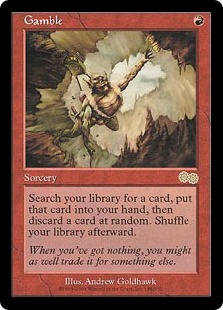
Variance has been studied extensively by biologists, psychologists, the gambling and gaming industries, and many others. Variance has plagued many Magic players over the years. Some call it luck. Other players refer to it as randomness. Many authors and articles have tackled the subject on an individual player basis. Today, I want to discuss variance on the macro level and its effect on Magic. Game Variance
Variance measures how far a set of numbers spread out. The spread dictates the number of outcomes. For example, a person flipping a coin has a very small amount of variance with only two outcomes. Lotteries operate on variance. Small lotteries have a lower amount of outcomes compared to mega lotteries. The range of numbers to choose from and amount of picks can be tweaked to either increase or decrease the number of outcomes. This is a daily occurrence for Magic players as they tweak and refine decks.
Before moving on, let’s hit some basics so everybody is on the same level. A common pattern seen in variance is the bell-shaped curve. For example, gather a hundred people and give them each a coin, then have each person flip the coin ten times. Record how often each person flips up heads or tails. If we plot the number of people with the same outcomes, a bell-shaped curve will form. Very few people will have gotten tails all ten times. The same will be true for the amount of people getting heads all ten times. The vast majority of people will have flipped tails about five times. Plotting the data will reveal a bell-shaped curve. A rough example is below.
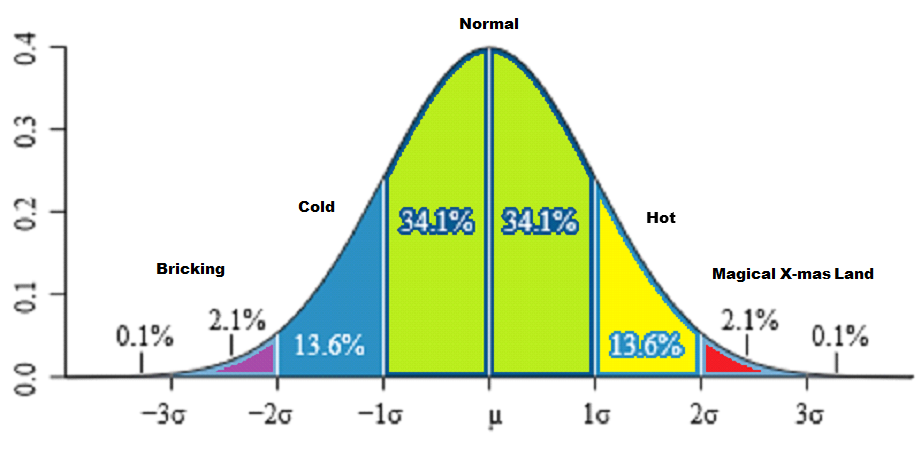
Every given deck has some amount of variance. The graph above is a mock-up of variance in a game of Magic. Every deck will run normal 68% of the time. Players running hot are in the 13% range. In 2% of our games, the perfect hand is drawn and everything falls into place. On the flip-side, some decks can brick some small percentage of the time. These numbers are purely hypothetical, but there is some credence to the matter. Every Magic deck operates on a bell-shaped curve. The numbers are simply tweaked depending on the deck.
Power Level vs. Variance
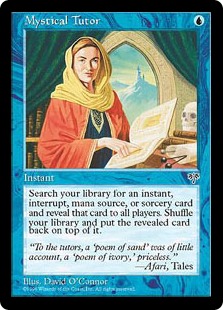
One of the biggest lessons I learned about variance was from a fluke during the original Ravnica metagame. Around this time, a deck called Ghost Dad was running around the tournament scene. The name originated from the card Ghost Council of Orzhova being included in the sixty. The key combo to the deck was Promise of Bunrei paired with Nantuko Husk. The scary combo was Nantuko Husk sacrificing some other creature to trigger the Promise of Bunrei. Then, those tokens could be sacrificed to make a 12/12 Nantuko Husk. Boom. Dead.
The deck was rampant until some professional players pointed out just how bad the deck really was. When the deck ran hot, it killed the opponent quickly. When it ran cold or even normally, it was a horrible, horrible deck. The deck also made something ridiculous like 50% of the field, so of course it was placing in the top 8. Due to variance and the sheer number of people playing it, a few of those would run hot at a tournament and “get there.” Once this was cleverly pointed out, it almost completely vanished. I don’t think it ever again cracked the top 8. The deck was overrepresented.
There are decks, especially in Legacy, that are allowed to stay because those decks have a high level of variance. However, when they run hot, they invariably win the game due to their enormous power level. Those decks are allowed to exist because of their inherent variance. Reanimation and Show and Tell strategies are examples in Legacy that fit this issue. There is a segment of the community that feels certain cards within these strategies should be banned due to their power level. Opponents to a ban will point to top 8 results to show these decks are not dominant. Those people are missing a key fact here. There are two issues being discussed at once. Basically, I feel many people are arguing apples and oranges. Power level and variance are two entirely different subjects.
The banning of Mystical Tutor in the Legacy format is a good example of these intertwined issues. For a time, Reanimator decks were dominating the Legacy field. The strategy was successful by tutoring up key pieces of the combo either with Entomb to find that giant fatty or Mystical Tutor to find a reanimation spell like Exhume. Mystical Tutor had another advantage in helping to find counter magic mainly in the form of Force of Will to help push through the combo. Regardless, the tutors made the deck extremely consistent. In the end, Mystical Tutor got banned as being the more powerful of these tutors.
Problems with Power
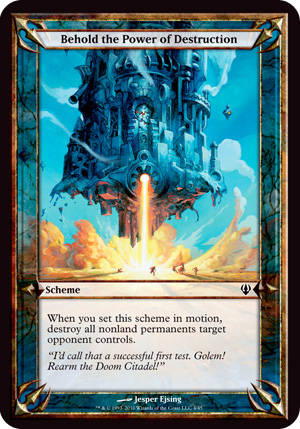
This brings me to a largely ignored problem I take issue with. Even when powerful decks have variance issues, those decks can still cause havoc on the tournament scene. When enough people play those powerful strategies, those decks will still dominate a tournament a certain amount of the time when they run hot. I call it the viper effect. For example, take 20 jars and 20 people. Put poisonous snakes randomly in ten of them. Then, instruct each person to reach into those jars. We now have ten dead people. If we repeat this over and over again, eventually all 20 of those people will eventually get bitten. This happens because vipers with deathtouch are extremely lethal. Powerful decks work the same way. Sure, they only work 50% of the time, but when they go off, they kill their opponents decisively. They either absolutely crush or don’t.
I believe it foolish never to worry about the power level of decks. Usually, consistency is the designated scapegoat. If one takes a gander at any banned/restricted list, many of those spells are banned/restricted because they enable or add consistency to those strategies. Power level can be just as dangerous, but people are fooled because those decks have variance issues. If enough players played those decks, they would dominate a tournament. Sure, many of those players wouldn’t make it to the top tables. However, variance works both ways. A lucky few will run hot and crush their opponents and make it to that top 8 bracket.
To assure readers, this is not an article promoting a ban for certain powerful cards. I am simply trying to bring light to an issue that I feel gets largely ignored. Part of the problem is variance can be measured by analyzing the results of the top 8 at tournaments. Analyzing the power level of a card is much more subjective and contextual. Wild Mongrel was a key card in Madness decks. However, it was a cog in the machine. Anyway, I do feel it is a subject that we need to be cognizant of more. Just because a variety of decks can be seen in those top 8 results doesn’t mean power level isn’t a problem.
The gauge at which power should be judged is how early it is deployed. An example was Dark Depths in Extended when it still existed as a format. During that window of time, it was not uncommon to have players creating 20/20 indestructible flying tokens on turn two with the help of Vampire Hexmage. If an opponent didn’t have Path to Exile, it resulted in a “free win.” Cards like Dark Confidant, Thoughtseize and Chrome Mox helped to enhance the strategy. The main problem was the short window of opportunity. Players had very little time to interact with their opponent. Path to Exile was one of the few options available in those early turns. A Path to Exile in an opening hand didn't guarantee safety. It could still be taken with a Thoughtseize or countered. This small window of opportunity greatly reduces the cards available to interact with an opponent.
Arguing power level is subjective and only leads heated arguments. The focus or the question that should be asked is it too early in the game state? The problem is an opponent has little time to find answers to the problem or develop a defense. For example, an extra turn would allow a number of options such as Lingering Souls tokens that can chump block for a few turns. Timing is everything. Take any argument about power level and tweak the turns it takes to deploy a powerful threat. Let’s talk again about Show and Tell and pretend players aren’t deploying any combo with the card till turn 12. Would you care at that point? The answer should be no. The problem with Show and Tell these days is the speed at which it combos with cards like Griselbrand are being deployed. A turn one Griselbrand off a Show and Tell with the aid of Ancient Tomb and Lotus Petal is the problem. Magic will always have powerful effects or creatures. I think those are fine as long as they are not too early in the stages of the game.
Survival of the Fittest?
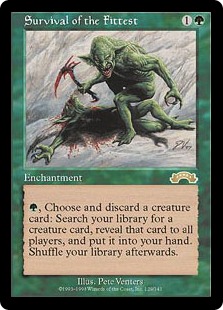
Every once in a while, we see some deck like Enchantress or Goblins crack the top 8 of a Legacy tournament. Statistically, it will happen. If enough players keep playing those decks over a given period of time, they will eventually run hot. At the same time, their opponents may have also ran very cold that day. Was the Enchantress deck really the best metagame deck for that tournament? Many writers will say yes and it was brilliant to play such a deck. I call it new hot deck hype. In reality, it was simply variance. Statistically, if I play the lottery long enough, perhaps a billion years, I will eventually win.
Food Chain is such a deck in Legacy. The combo with Misthollow Griffin is incredibly powerful, but the deck suffers from having a huge amount of variance. Prices for Food Chain spiked as a result of one top 8 finish. Let me say that again, one, just one top 8 finish. Don’t get me wrong, I love, love the idea of using Food Chain combo with Misthollow Griffin and the deck has potential. However, when looking at the top 8 of any tournament, a player must keep the fact variance does exist. One top 8 finish does not necessarily equal a good deck. Since that one top 8 finish, I have yet to see another Food Chain deck crack into the upper bracket.
I realize people get excited when something new crops up in a format. I do as well, but as players we must be realistic at the same time. We must keep in mind those results may simply be a fluke, a blip on the radar, or an outlier. There are so many other variables to consider. Who piloted the deck? What did their opponents play? How big was the attendance? How good were their sideboards? Did their opponents brick? Did their opponents have any misplays? The list could go on and on. It is very easy to point to the results of a top 8 and say this is the best deck. It’s even easier when those decks are piloted by professionals.
The biologist in me would love to relate top 8 finishes to natural selection. In truth, successful decks have more in common with economics. Decks don’t abide by the strict laws of nature. The key here is people. Humans play Magic. I hope I’m not bursting anyone’s bubble, but humans make mistakes. We choose our decks. This distorts the reality of what is actually the best deck. Let’s pretend for a moment it was possible to input Magic into a super computer. At the end of some lengthy time interval, it would spit out the result of the best deck as being 42, much like the meaning of life, the universe, and everything in The Hitchhiker’s Guide to the Galaxy. Anyway, let’s pretend it was some complicated combo deck like Storm. Would everyone suddenly play Storm? The answer is no. Players like nuts and bolts Magic. Players like their Tarmogoyfs.
As a fan, I am reminded of this every time I watch Feline Longmore play the underrepresented High Tide deck in Legacy. I like watching Feline play because it is like poetry. She is the Venus Williams of High Tide. She plays it because she likes it and is proficient with the deck. The point here isn’t about High Tide or proficiency. It is about the fact Magic is much more than simple statistics and variance. Stare at those top 8 results all you want, but sometimes they don’t mean much. Those statistics are cold and lifeless. Step away from the tree for a moment and look around at the forest.
Fools of Variance
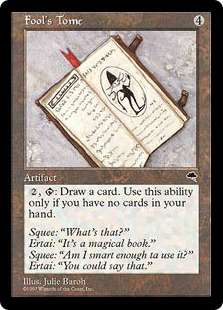
So you prepared for that tournament for months. The sideboard was in a perfect state. You got plenty of sleep. You double checked your decklist to ensure there weren’t any errors to trigger a game loss. You were in your prime. You took every step to ensure your success. And then, yes then, you lost three rounds in a row. You had to mulligan every game. Every opponent won the coin toss to go first. Everything went wrong and you had to drop after three match losses.
How was this possible? What did you do wrong? Well, actually nothing. It was variance. I think too many players are too hard on themselves. I listen to a number of podcasts and it’s a common theme I hear over and over again. During these segments, many players are bummed for not making it further in those tournaments. There is talk about the need to do more to “make it.” In reality, it is very possible it was simply a case of variance. Sorry, nothing you could have done about it. The moral of the story is not to feel too bad about losing. My best story was at a Legacy Grand Prix. I was against an opponent playing Goblins. All I needed to do was draw anything but a land. Any spell in my deck would have clinched the game. I drew eight land in row. My opponent and I couldn't believe it. Eventually, my opponent drew the game winning spell and I lost. He gave one of those sympathetic looks and somewhat apologized for the win. I knew it and he knew it that variance had gotten the best of me.
I’m not saying players only lose because of variance. There have been many articles over the years explaining on how to maximize one's odds. Many good players consistently make it to the top tables. They have learned to minimize the issues of variance. However, they too are not immune. Half the reason those players make it to the top consistently is because they play in a lot of tournaments. What did we learn about variance? Playing in more tournaments increases the chances of getting into the top 8. If you want to get onto the Pro Tour, you need to play in a lot tournaments. You won’t win every game. You won’t win every tournament. Variance will sometimes get the best of you. However, every squirrel eventually gets a nut.
Just Brainstorming
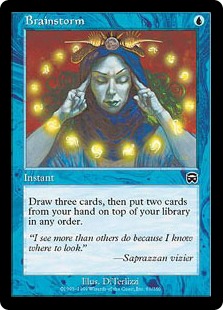
The inclusion of Brainstorm in the Legacy format has been a divisive topic. Some want a ban while others passionately defend its position in the game. Part of the problem I feel is Brainstorm operates on many levels. Whenever I hear a conversation about Brainstorm, I can’t help but think of those cheesy infomercials. It slices. It dices. It makes Julienne fries. You too can have it for the low price of one mana. It combos with Counterbalance, it hides cards from discard, and many other things.
What is the function of Brainstorm at the most basic level? At its core, it is a variance reducer. It is all about you finding the card you need when you need them. With Counterbalance, it’s about finding the right card to put on top of your library to counter your opponent’s spell. With fetch lands, it is about shuffling away unwanted lands to find the cards you want. Just think about variance with future conversations about Brainstorm.
Viewing Brainstorm as a variance reducer allows us to have a productive conversation. We can clearly define variance. It is objective and concise. Barring tutors like the banned Vampiric Tutor, Brainstorm (for its mana cost) is the best card available in the game to reduce variance in any deck. For the sake of this discussion, let’s say Brainstorm was banned. Such a ban would cripple a variety of archetypes. The power level of those decks would remain intact. However, a ban would greatly increase the variance in those decks. Some decks would be able to survive with other adaptations, but not at the speed and efficiency as Brainstorm.
A better question to ask is whether the format would be healthier with a Brainstorm ban? Keep in mind, I am mostly ambivalent about the subject. I can’t help but think of the days with no deck restrictions. Game play was repetitive and degenerate. Deck restrictions increased the variance of the game. Variance to me is the quiet secret that makes Magic tick. Well, maybe it is not my secret. Mark Rosewater has actually talked on more than one occasion about its importance. Anyway, variance is good. Brainstorm decreases variance. A ban would increase variance. So… increasing variance would be good for the game, right?
However, we must also look at the big picture. Let's just pretend Brainstorm is ban-worthy. Does a ban increase the variety of decks in the format? A ban increases variance, but the result could actually decrease the variety of decks playable in the format. There are many strategies like Infect decks that are glued together with the aid of Brainstorm. A banning could erase that particular strategy from the environment. The format could suddenly be dominated by one particular archetype. I doubt anyone wants such an environment. The hard truth is no one can predict the outcome of such a ban. Although, it would be interesting to see the actual results of such a ban even if momentarily. In the end, I don’t care if Brainstorm is banned. What I care about is the health of the format. If it means axing the efficient variance reducer that is Brainstorm, so be it. However, a ban should not be initiated if it does not improve the health of the format. This is regardless of how good Brainstorm actually is in Legacy.
Meyou
-
View User Profile
-
Send Message
Posted Oct 12, 2014With all of this said, I am of course a fan of interactivity in magic so I always approve of altering the format to ensure interactivity. I think there are enough answers in legacy that very few cards are strictly uninteractive though I admit that force of will is definitely part of the reason for this.
-
View User Profile
-
Send Message
Posted Oct 9, 2014When your hand consists of 2 Forests, a Plains and the single Swamp you use for flashbacks. And Presence of Gond , Midnight Guard and Altar of the Brood
I drew this hand in a free-for-all of 4 people. A Dimir Miller, Dimir Counter-deck and a Penta Maze's end focused deck. The game was fairly short ; no damage was dealt. And in turn 12 every player other than myself either conceded or decked out. And I never even made 60+ Elves. Just 40, and playing lands and permanents milled you about 6 earlier I bet you regret drawing so much, Dimir miller.
On a bad day however, I get 2 Intangible Virtue, Emmara Tandris, Wayward Temple and never in that game actually manage to create a token. *Ducks behind Archer's Parapet hoping for hell that I get a Swamp or evolving wilds.*
-
View User Profile
-
Send Message
Posted Oct 5, 2014On a somewhat separate note, I've always been of the opinion that variance is one of the core enablers of hidden information in Magic, one of the most important contributors to it's strategy and depth. While it is possible to introduce hidden information to a game with no variance, those methods are limited, and can't take it to the same depth as Magic. On that note, similar to how you stated that brainstorm can is arguably detrimental to the game in how it reduces variance and streamlines the game (though, agreeably that's a rather farfetched argument) cards like thoughtseize, courser of kruphix, or probably better yet, something like wandering eye, also are, in my opinion, limiters of variance. While these cards obviously don't actually alter whether or not a game is different to others, it does however, make games more streamlined and ultimately predictable. One of the reasons I believe magic to be fun, is because nearly anything can happen, and players are benefited by the speculation of what the most likely outcomes are (ie: applications of hidden information) granting players additional information which let them simply crunch numbers to achieve the desirable outcomes, warps the game in an arguably detrimental way, and certainly eliminates a degree of much of the traditional applications of variance.
Thoughts?
-
View User Profile
-
Send Message
Posted Sep 30, 2014Actually only about a quarter of people will have flipped tails five times. I mention this because it illustrates a point related to this topic that a lot of people don't understand: The most likely outcome is not necessarily very likely. You move on to discuss other elements of variance so it's not directly connected with most of your article but I still think it's important to note.
-
View User Profile
-
Send Message
Posted Oct 4, 2014-
View User Profile
-
Send Message
Posted Sep 30, 2014-
View User Profile
-
Send Message
Posted Sep 30, 2014